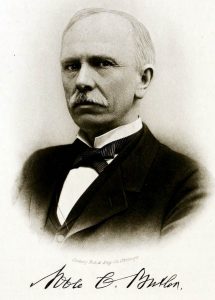
Photo info …
Credit: Dave Francis via Find A GraveView Source
(Feb. 21, 1844-Oct. 7, 1933). Born in Salem, Indiana, Butler attended Hanover College (1860-1863) before joining the 93rd Indiana Volunteer Infantry Regiment, serving in telegraphy and army intelligence. Following the Civil War he read law with his father, John H. Butler, and , studied law at the University of Louisville (Kentucky), and joined his father’s New Albany law practice.

In 1867 U.S. Supreme Court Chief Justice Salmon E. Chase named him a registrar in bankruptcy in New Albany. Butler moved to Indianapolis in July 1879, to become clerk of the U. S. Circuit (until 1912) and District courts, a position he held until retiring in October 1922.
A nationally recognized authority on bankruptcy law, Butler lectured on federal jurisprudence at the Indiana Law School (1902-1928) and the law school at Indiana University. Known as both an orator and essayist, he contributed frequently to the , the , and other literary reviews.
Butler was one of the incorporators of the National (American) Red Cross, the Indiana chapter of which was established in his home. He was a member of the , , and the American and Indiana bar associations. He died at his home at 1204 North Park Avenue, the , a historic house held by , and was interred in .

Help improve this entry
Contribute information, offer corrections, suggest images.
You can also recommend new entries related to this topic.

